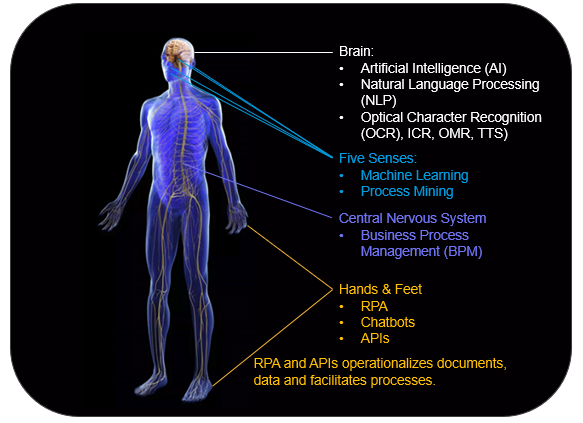Gartner defines hyperautomation as “a business-driven, disciplined approach that organizations use to rapidly identify, vet and automate as many business and IT processes as possible.”
Emphasis on “business-driven, disciplined approach” because it emphasizes why organizations should adopt hyperautomation. The goal is not to automate every process. Rather, it should be to automate processes that deliver significant business value.
In fact, the only processes that should be automated are those that deliver:
- Superior experiences for customers, employees and partners
- Significant cost or processing time reductions
- Opportunities for new revenue generation (expanding the pie)
These efforts should be governed by a methodology that carefully defines how candidate projects are identified, selected and measured for success, so that your hyperautomation efforts don’t run amuck and become the hammer that makes every process look like a nail.
Hyperautomation Isn’t One Technology. It’s Several.
Technically, what is hyperautomation? Is it AI, RPA, BPM? Is it a methodology?
It’s actually all of them — and a lot more.
Hyperautomation is not a singular technology. Rather, it’s a disciplined approach to applying a spectrum of technologies tasked with improving the way in which your organization functions.
Understanding Hyperautomation Through the Metaphor of the Body
To help better understand this spectrum, at least from a technology components perspective, let’s look at a simple analogy. If hyperautomation was the human body, where would the underlying technologies fit best?
(Warning: I’m not a trained physiologist. My classical training in physiology ended freshman year of high school so beware.)
Let’s start with signal inputs. Starting with the five senses, I see process mining and machine learning fitting here most because these technologies determine what signals should be processed and a method for identifying those relevant signals. Process mining tells the body what signals it should be processing while machine learning identifies and classifies the signal itself. In other words, these are the signals we are looking to process and here is what they look like.
Next, once we’ve identified that a signal is relevant, a message is passed through the central system (CNS) to the brain for processing that signal. In the hyperautomation space, messages are routed by technologies like Business Process Management (BPM) to the brain for processing.
Once a signal is presented to the brain, recognition technologies like natural language processing (NLP), OCR, ICR, OMR, and Text-to-Speech interpret the signal, which in turn feeds the AI engine to determine what action should be taken. Feeding the AI engine with these signals expands the AI engine’s knowledge base.
Finally, once the brain decides what needs to be done, it routes an instruction for physical action back through the CNS to the subsystems where actions can be executed. This is where technologies like RPA, Chatbots and APIs come into play, serving most often as the hands and feet (some of the automations I’ve seen developed look like they were crafted by someone’s feet) to get work done.

Simple, right?
Getting your mind around every aspect of the hyperautomation spectrum can be daunting. So don’t play that game.
Rather, look at hyperautomation as a toolbox from which you can draw to get both little and big things done. Don’t be afraid to start out small, learn, accumulate some quick wins and work your way up from there.
The bottom line is if you focus on your people and processes — and the best tools to empower them — rather than immersing yourself in the sea of tech acronyms, you’ll get better and faster results.
